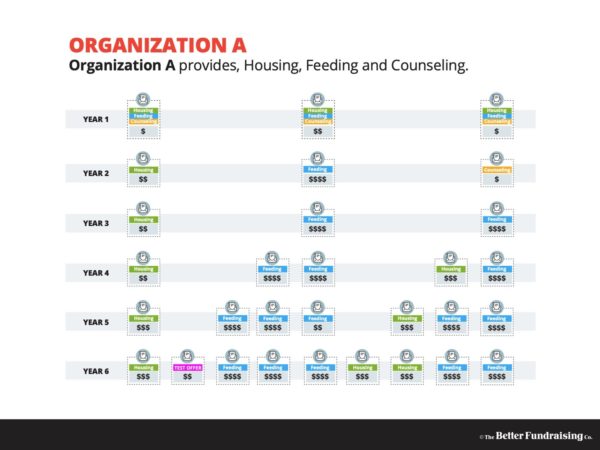Concern for “asking too much” holds back a surprising number of nonprofits from raising more money and doing more good.
This (very long) post is an attempt to show that of course you can ask too much. And that being concerned about “asking too much” is honorable.
But it will also show that, in all likelihood, a smaller nonprofit doesn’t need to fear asking more.
This post is long for a reason. Here’s why. In my experience, the belief that “we are on the edge of asking too much right now” is a core belief at many organizations. The assertion than an organization can and should be asking more often challenges that core belief.
People and organizations don’t change their minds like flipping a light switch, when it comes to core beliefs. It takes time to change a worldview.
This post gives you that time. It lets the idea sink in. It shares a couple of stories. It looks at the situation from a couple of angles.
So let’s get started. Because thinking a little differently about this one issue can help a nonprofit do a lot more good…
Who Is This Post For?
This post is for smaller organizations.
This is for organizations who mail fewer than ten pieces of direct response fundraising (appeals, newsletters) per year, and fewer than twenty-five fundraising emails per year.
This is for smaller organizations with staff or board members who have concerns about donor fatigue.
If your organization fits any of those criteria – and you’d like to raise more money – keep reading.
Story Time
Let me tell you a quick story. I’m telling you this to begin the process of expanding your idea of what’s possible for smaller organizations.
I work with a handful of organizations that send out between twelve and sixteen printed appeals each year, along with between three and six printed newsletters. They also have strong email fundraising programs.
That’s a lot, no? It might even seem like their experience doesn’t apply to your organization and your donors.
But it does. Because they’re concerned about asking too often, too.
Recently, for an organization that sends out twelve appeals a year, we had a meeting to create the fundraising calendar for the year. I noticed there was a gap between two appeals where we could squeeze in another printed appeal.
They wondered if it was the right thing to do. They thought they were on the edge of asking too much.
I asked them, “Have you ever regretted adding another appeal?”
“No,” they replied.
I said, “We’ve analyzed the results of your appeals, we constantly look at your donor retention rates. Have the positives of adding another appeal always far, far outweighed the negatives?”
“Yes,” they replied.
There was a brief period of silence. Then they said…
“OK, let’s do it. When should this drop? Which donors should we send this to?” And off we went.
Even the big organizations are concerned about asking too much.
But – and this is an important “but” – they analyze the performance of their fundraising and they see that asking more often helps them raise more money and keep more of their donors.
And here’s the mind-expanding thing: it’s a statistical certainty that your organization’s donors are also giving to some of those big organizations.
If you think that asking your donors so often would never work for your donors, please know that it works all the time. It’s working right now.
Comes from a Good Place
The concern about “asking too much” comes from a good place.
It comes from a healthy desire to keep your donors. It comes from getting feedback from a couple of important donors like, “you guys are sending me too much stuff.” It comes from wanting to emphasize the positive aspects of their beneficiaries and de-emphasize needs.
Those are good and honorable impulses.
However, if you base your fundraising strategy on only those reasons, you’ll raise less than you could be in the short term and in the long term. And you’ll do less good.
Because you also need to base your fundraising strategy on a tactic that other organizations have found allows them to raise more and do more good.
Your organization should ask itself two questions:
- “If other organizations are being successful asking more, why can’t we?”
- “If asking more often is an established way to help us do more good, don’t we owe it to our beneficiaries to try it a couple of times?”
A Vestigial Value
There’s another reason “asking less” is perceived to be a positive value.
This reason is a holdover, a memory of when you were a smaller organization. You knew all of the donors. You knew that they were likely to read everything you sent out.
You had a personal connection with them. You didn’t want to bother them with too many asks.
But as an organization grows, donors like that are a smaller and smaller percentage of who you communicate with.
A communication strategy of asking twice a year when you have 150 donors and know most of them can work great. But asking twice a year when you have 1,000 donors and know 150 of them will not work well.
Make sure you aren’t applying a lesson from when you were smaller to your current stage of growth.
Isn’t It Weird That “Too Many” is Always “One More” than They’re Currently Sending?
When I first started talking with organizations about this I noticed a pattern:
- Orgs that send one annual appeal believed they could never send two appeals
- Orgs that send two appeals believed they could never send three appeals
- Orgs that send three appeals believed they could never send four appeals…
You get it.
My recommendation: don’t base your understanding of “how many appeals we can send” off of how many appeals you’re sending now. Instead, base your answer on how many appeals high-performing organizations are sending.
The time and money to write, design, and purchase postage for appeals can be a real barrier (which I’ll talk about later).
But the belief that you can’t ask more shouldn’t be a barrier.
It might make your organization uncomfortable to try it. But isn’t a little discomfort worth it for the ability to raise more money and do more good?
Beware Inapplicable Information
As you think about asking more often, you’ll get some pushback. Here are some common examples:
- A Board member that says we can’t ask more than we currently are
- A blog post (like this one or this one) that says to stop abusing donors with so many Asks
- A Major donor that says she doesn’t like appeal letters
When this happens, check to make sure the lesson applies to your organization. For instance:
- That Board member who says you can’t ask more likely doesn’t know much about direct response fundraising and hasn’t done it at scale. He doesn’t know what more sophisticated organizations are doing, and his opinion shouldn’t determine your approach.
- The linked blog posts above are mainly aimed at super-large organizations. They aren’t written for organizations with two-person development teams who send out three appeals. (And nothing at all against the Agitator – I love them and kind of want to be them when I grow up.) Smart advice for an organization with 200,000 donors is not necessarily smart for an organization with 2,000 donors.
- A Major Donor’s communication preferences should be honored for her, but her preferences should not determine your organization’s policy. If she doesn’t like appeal letters, use segmentation to take her out of most of your appeal letters.
The fundraising world is full of good advice, opinions and research. Just make sure it applies to your organization at your stage of growth.
Don’t Fear the Bogeyman
I’ve noticed that when organizations consider asking more, they have outsized fears around the possible negative consequences.
- They fear a significant number of major donors will never give agai
- They fear a massive number of unsubscribes from the email list
- They fear donors will give a gift now but won’t give at the end of the year
We can tell you from experience that these fears don’t materialize.
Three quick real-life examples:
- A client sent four printed appeal letters in four weeks, with no greater opt-outs or complaints than normal;
- A client sent twenty-four e-appeals over nineteen days, with fewer unsubscribes than normal
- A client went from four appeals to seven a year with zero negative feedback.
Will you get a complaint, an opt-out or two? Of course. But they’ll be minimal. And held up in direct comparison to the additional gifts and higher retention rates, it’s a “trade” most organizations would make every day.
Step by Step, Not Overnight
The organizations that are sending out ten successful appeals per year weren’t born that way.
They probably started at two. Then they added a third. Then a fourth. Years later, they were up to eight. And so on. They measure their results. And they keep adding appeals until their data (not one person’s opinion) shows them that they should stop.
If you’re sending three appeals a year, I don’t recommend jumping to eight. But I sure recommend jumping to four or five.
It’s a multi-year process to get to that many appeals. You figure out what types of letters and subjects your donors are most likely to respond to, and add appeals step by step.
The process often looks like the following chart. In “year 1.” the organization is sending three appeals. By year six they are sending out nine appeals and raising a LOT more money:

So if you’re worried that you and your team have to immediately triple or quadruple the amount of fundraising you send out, you can relax.
It really is a multi-year process. You add a couple of appeals. You raise more money. You do more good, and you hire another Development person. Then you’re able to do a couple more appeals. Then you raise more… step by step.
If you’re becoming more comfortable with the idea, “hey, maybe we could send one more,” then I’m thrilled for you. Because for smaller organizations who are only asking their donors a couple of times a year, the ability to ask more often is the easiest way to raise more money.
Don’t Send Everything to Everybody
Please know that most organizations that send ten appeals per year don’t send all ten to everyone.
Segmentation is your friend.
To give you an example, here are some super-simple segmentation recommendations for an organization that sends out ten appeals:
- To your mass donors, send all ten of your appeals.
- To the major donors you’re actively in relationship with, send two appeals.
- To the major donors you’re not in active relationship with, send six appeals
- To your monthly donors, send three appeals and be sure to customize them to acknowledge their faithful monthly giving.
- For every appeal, feel free to pull any single donor or any small group of people out. Examples: your Board, a major donor you’re preparing a major ask for, or a person who just notified you that they’ve put your organization in their will.
Knowing that you don’t send all ten of those appeals to everyone is often tension-reducing, shoulder-lowering news for smaller organizations!
Add Functionality and Skills as You Grow
As organizations Ask more often, they tend to add new skills to their fundraising repertoire. These are skills and processes like:
- Setting up their CRM to automatically send a printed receipt within 24 to 48 hours
- Using segmentation (as mentioned above)
- “Reporting” to their donors so donors know their gift made a difference
- Use more direct response fundraising best-practices, then regularly measure and analyze results.
Do you need to do all those things if you’re moving from two appeals a year to three? No.
But do savvy nonprofits add those functions over time because they are proven to work?
Yes.
More Practice = More Money
Just “asking more” isn’t a magic bullet.
If you send eight appeals full of organizational-centric fundraising that “sounds like us” and tells stories of people you’ve already helped… it’s not going to go well. (You’ll still raise more money than you were before, but you’ll leave a lot of money on the table.)
So for smaller organizations to send more appeals, they also need to get better at appeals.
If you’re a small organization, you have three incredible things going for you:
- Pent-up giving. If you’ve only been asking a couple of times a year, you have what we call pent-up giving. The next appeal you send will raise money almost regardless of what’s in it. Why? Your donors have been wanting to do more but you haven’t asked them to.
- You get better at appeals the more you practice. Creating effective appeals is a learned behavior, and you’ll absolutely get better with practice.
- You’re living in a golden age for learning fundraising. There’s so much free, high-quality information out there. Subscribe to our blog. Follow Jeff Brooks. Read The Agitator. Follow Lisa Sargent, Tom Ahern, Mark Phillips and T. Clay Buck. Read Erica Waasdorp’s book. Follow Next After. Look up the Agents of Good. I’ve been doing this stuff for twenty-seven years and regularly get better at it thanks to these fine people.
But You CAN Ask Too Much
The way to tell whether your organization is asking too much is to do some math. And I’ll give you the two main ideas below.
It’s good to note that sophisticated organizations use a host of tools and analysis to know when they’re asking too much. But as we’ve made clear, this post is not for them.
So here’s how to know if your organization is asking too much…
- The first idea is to do a Cost/Benefit Analysis to see how much of the additional revenue from an additional appeal is “new revenue” – or is revenue that’s “stolen” from the appeal that mails right before it or after it. Once you calculate the new revenue, you figure out the relative cost of that new revenue compared to other appeals and to all of your other fundraising options.
- In my experience, you don’t have to worry about this until you get to at least ten printed appeals and newsletters (total).
- The second is to measure and monitor the retention rates for your donors. Each different segment of your donors (New Donors, Monthly Donors, Major Donors, etc.) has known strong/acceptable/weak retention rates. If you find that a particular segment’s retention rate is dropping, one of the culprits can be asking them too often.
- If you’re at a nonprofit that is small enough that you’re not measuring retention rates by segment, you almost certainly can (and should) be mailing more.
Most small organizations don’t need analysis to know whether they can add another appeal or two. In my experience, I start to pay attention to the analysis when reaching ten appeals per year. And then really start digging into the details at about twelve or fourteen appeals per year.
If you’re mailing less than eight appeals per year, my recommendation is that you can add two appeals without thinking twice.
Quick story to provide context. I once served an organization where we ran a test. We started increasing the number of mailings (appeals and newsletters) to a group of their donors. We measured the results rigorously.
We got to the point where we were mailing those donors twenty-four appeal letters and twelve newsletters each year before the data told us that we were mailing too much.
24 printed appeal letters and 12 printed newsletters!
Do I recommend you send that many mailings? Of course not.
But doesn’t hearing that make you think you could be asking your donors a couple more times each year?
Human Resources Matter
Hopefully you are now open to the idea that your organization could be asking more.
It’s entirely another thing to write, design, print and send or email the additional asks. These things take real time, energy and money.
If you’re a small shop and working at max capacity, what do you do?
This issue must be addressed, but it’s not what this particular post is about. But here are some quick ideas to help you see how it’s possible:
- You can repeat your strongest appeals and e-appeals. If last year’s year-end appeal worked great, you can use it again this year with only the slightest modification. If you run a spring campaign that works well, you can likely run a fall campaign that uses the same words, phrases and paragraphs. Don’t feel like you have to re-invent the wheel each time. Savvy Fundraisers purposefully repeat things that work. Assets, not art projects.
- Sign up for the program at Work Less, Raise More. The trainings there (more being added each month) will help you produce effective fundraising very quickly.
- Steal like an artist. There are no new ideas in fundraising. Take an idea or tactic that another organization uses successfully, revise it to fit your organization and your context, and you’ve made a new thing.
- Know that each piece of fundraising you send out is not precious.
In Sum
I don’t want you to fear “asking too much.”
I want you to be free of the “donor fatigue” bogeyman. (Actual sightings happen about as often as actual sightings of a Sasquatch.)
The organizations that we’ve helped communicate more have never regretted it:
- They found they were overestimating the negative consequences of communicating too much
- And they found they were underestimating the generosity of their donors
So if you’re an organization that is wrestling with whether to ask more, you could be asking more.
You have pent-up giving waiting to be unleashed.
You could be doing more good!
Acknowledge your concerns – they come from a good place.
Show me a smaller organization that moves past their fears about asking too much and I’ll show you an organization that is about to raise more money, keep more of its donors, and make “the leap” to the next level of growth and impact.
Steven Screen is Co-Founder of The Better Fundraising Company and lead author of its blog. With over 30 years' fundraising experience, he gets energized by helping organizations understand how they can raise more money. He’s a second-generation fundraiser, a past winner of the Direct Mail Package of the Year, and data-driven.









5 comments on “Of Course You Can Ask Too Much (but you almost certainly aren’t)”